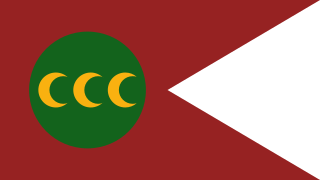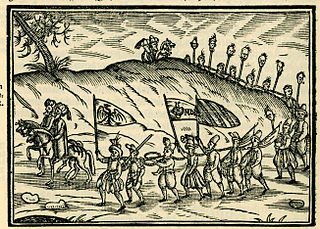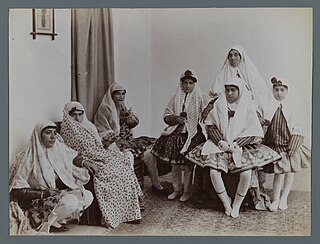
The Ottoman Empire, historically and colloquially known as the Turkish Empire, was an imperial realm that spanned much of Southeast Europe, West Asia, and North Africa from the 14th to early 20th centuries; it also controlled parts of southeastern Central Europe between the early 16th and early 18th centuries.

In Islam, the ulama, also spelled ulema, are scholars of Islamic doctrine and law. They are considered the guardians, transmitters, and interpreters of religious knowledge in Islam.

The Tanzimat was a period of reform in the Ottoman Empire that began with the Gülhane Hatt-ı Şerif in 1839 and ended with the First Constitutional Era in 1876. The Tanzimat era began with the purpose not of radical transformation, but of modernization, desiring to consolidate the social and political foundations of the Ottoman Empire. It was characterised by various attempts to modernise the Ottoman Empire and to secure its territorial integrity against internal nationalist movements and external aggressive powers. The reforms encouraged Ottomanism among the diverse ethnic groups of the Empire and attempted to stem the rise of nationalism in the Ottoman Empire.

Timariot was the name given to a Sipahi cavalryman in the Ottoman army. In return for service, each timariot received a parcel of revenue called a timar, a fief, which were usually recently conquered plots of agricultural land in the countryside. Far less commonly, the sultan would grant a civil servant or member of the imperial family a timar. Also non-military timar holders were obliged to supply the imperial army with soldiers and provisions.
In the Ottoman Empire, a millet was an independent court of law pertaining to "personal law" under which a confessional community was allowed to rule itself under its own laws.

The history of the Ottoman Empire in the 18th century has classically been described as one of stagnation and reform. In analogy with 18th-century France, it is also known as the Ancien Régime or Old Regime, contrasting with the "New Regime" of the Nizam-i Cedid and Tanzimat in the 19th century.
The rise of the Western notion of nationalism in the Ottoman Empire eventually caused the breakdown of the Ottoman millet system. The concept of nationhood, which was different from the preceding religious community concept of the millet system, was a key factor in the decline of the Ottoman Empire.

In the Ottoman Empire, women enjoyed a diverse range of rights and were limited in diverse ways depending on the time period, as well as their religion and class. The empire, first as a Turkoman beylik, and then a multi-ethnic, multi-religious empire, was ruled in accordance to the qanun, the semi-secular body of law enacted by Ottoman sultans. Furthermore, the relevant religious scriptures of its many confessional communities played a major role in the legal system, for the majority of Ottoman women, these were the Quran and Hadith as interpreted by Islamic jurists, often termed sharia. Most Ottoman women were permitted to participate in the legal system, purchase and sell property, inherit and bequeath wealth, and participate in other financial activities, rights which were unusual in the rest of Europe until the 19th century.

Slavery in the Ottoman Empire was a major institution and a significant part of the Ottoman Empire's economy and traditional society. The main sources of slaves were wars and politically organized enslavement expeditions in the Caucasus, Eastern Europe, Southern Europe, Southeast Europe, and Africa. It has been reported that the selling price of slaves decreased after large military operations. In Constantinople, the administrative and political center of the Ottoman Empire, about a fifth of the 16th- and 17th-century population consisted of slaves. Statistics of these centuries suggest that Istanbul's additional slave imports from the Black Sea slave trade have totaled around 2.5 million from 1453 to 1700.
Esnaf is a Turkish word which means "corporation". During the Early Modern Period belonging to a guild gave people a voice and was an important part of one's identity. Handicraft producers were linked to one another by a range of social, political, and economic ties. Guilds varied among societies, social class, and genders. There were many misconceptions, differences, as well as similarities between Europe and the Ottoman Empire. There were hierarchies within guilds; sometimes they shared tools, worked together, or worked alone.

Military conscription in the Ottoman Empire varied in the periods of:

In AD 1453, the city of Constantinople, the capital and last stronghold of the Byzantine Empire, fell to the Ottoman Empire. By this time Egypt had been under Muslim control for some seven centuries. Jerusalem had been conquered by the Rashidun Caliphate Muslims in 638, won back by Rome in 1099 under the First Crusade and then reconquered by Saladin's forces during the siege of Jerusalem in 1187. Later in the seventh Crusade, it was taken back by the Catholics once again. It was conquered by the Ottomans in 1517. Orthodoxy, however, was very strong in Russia which had recently acquired an autocephalous status; and thus Moscow called itself the Third Rome, as the cultural heir of Constantinople. Under Ottoman rule, the Greek Orthodox Church acquired power as an autonomous millet. The ecumenical patriarch was the religious and administrative ruler of the entire "Greek Orthodox nation", which encompassed all the Eastern Orthodox subjects of the Empire.
Haraç was a land tax levied on non-Muslim subjects in the Ottoman Empire.
The resm-i bennâk was a tax on peasants who had little or no land - those who did not pay the resm-i çift - in the Ottoman Empire.

Suraiya N. Faroqhi, is a German scholar, Ottoman historian and a leading authority on Ottoman history. She was elected as a Corresponding Fellow of the British Academy for the year 2022, under the "Early Modern History to 1850" category.

Rūm millet, or "Roman nation", was the name of the Eastern Orthodox Christian community in the Ottoman Empire. Despite being subordinated within the Ottoman political system, the community maintained a certain internal autonomy.
Fitnat Hanım was the pen name of the Ottoman Turkish woman poet Zübeyde, "considered the most important woman poet of the Ottoman school".

The Ottoman era in the history of Arabia lasted from 1517 to 1918. The Ottoman degree of control over these lands varied over these four centuries, with the fluctuating strength or weakness of the Empire's central authority.

The Transformation of the Ottoman Empire, also known as the Era of Transformation, constitutes a period in the history of the Ottoman Empire from c. 1550 to c. 1700, spanning roughly from the end of the reign of Suleiman the Magnificent to the Treaty of Karlowitz at the conclusion of the War of the Holy League. This period was characterized by numerous dramatic political, social, and economic changes, which resulted in the empire shifting from an expansionist, patrimonial state into a bureaucratic empire based on an ideology of upholding justice and acting as the protector of Sunni Islam. These changes were in large part prompted by a series of political and economic crises in the late 16th and early 17th centuries, resulting from inflation, warfare, and political factionalism. Yet despite these crises the empire remained strong both politically and economically, and continued to adapt to the challenges of a changing world. The 17th century was once characterized as a period of decline for the Ottomans, but since the 1980s historians of the Ottoman Empire have increasingly rejected that characterization, identifying it instead as a period of crisis, adaptation, and transformation.

Concubinage in the Muslim world was the practice of Muslim men entering into intimate relationships without marriage, with enslaved women, though in rare, exceptional cases, sometimes with free women. If the concubine gave birth to a child, she attained a higher status known as umm al-walad.













